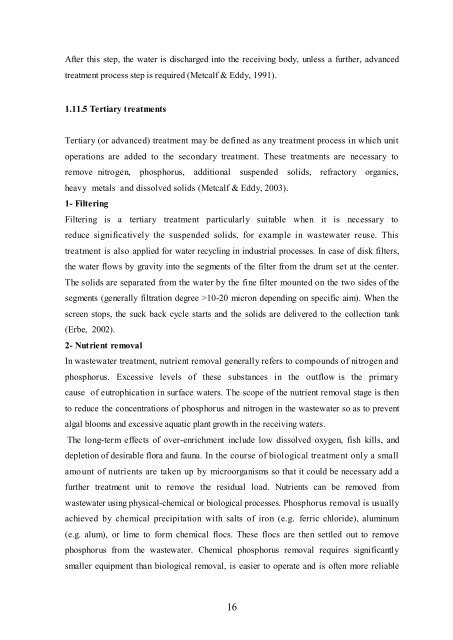Quds University Small Scale Waste Water Treatment Plants in West ...
Quds University Small Scale Waste Water Treatment Plants in West ...
Quds University Small Scale Waste Water Treatment Plants in West ...
Create successful ePaper yourself
Turn your PDF publications into a flip-book with our unique Google optimized e-Paper software.
After this step, the water is discharged <strong>in</strong>to the receiv<strong>in</strong>g body, unless a further, advanced<br />
treatment process step is required (Metcalf & Eddy, 1991).<br />
1.11.5 Tertiary treatments<br />
Tertiary (or advanced) treatment may be def<strong>in</strong>ed as any treatment process <strong>in</strong> which unit<br />
operations are added to the secondary treatment. These treatments are necessary to<br />
remove nitrogen, phosphorus, additional suspended solids, refractory organics,<br />
heavy metals and dissolved solids (Metcalf & Eddy, 2003).<br />
1- Filter<strong>in</strong>g<br />
Filter<strong>in</strong>g is a tertiary treatment particularly suitable when it is necessary to<br />
reduce significatively the suspended solids, for example <strong>in</strong> wastewater reuse. This<br />
treatment is also applied for water recycl<strong>in</strong>g <strong>in</strong> <strong>in</strong>dustrial processes. In case of disk filters,<br />
the water flows by gravity <strong>in</strong>to the segments of the filter from the drum set at the center.<br />
The solids are separated from the water by the f<strong>in</strong>e filter mounted on the two sides of the<br />
segments (generally filtration degree >10-20 micron depend<strong>in</strong>g on specific aim). When the<br />
screen stops, the suck back cycle starts and the solids are delivered to the collection tank<br />
(Erbe, 2002).<br />
2- Nutrient removal<br />
In wastewater treatment, nutrient removal generally refers to compounds of nitrogen and<br />
phosphorus. Excessive levels of these substances <strong>in</strong> the outflow is the primary<br />
cause of eutrophication <strong>in</strong> surface waters. The scope of the nutrient removal stage is then<br />
to reduce the concentrations of phosphorus and nitrogen <strong>in</strong> the wastewater so as to prevent<br />
algal blooms and excessive aquatic plant growth <strong>in</strong> the receiv<strong>in</strong>g waters.<br />
The long-term effects of over-enrichment <strong>in</strong>clude low dissolved oxygen, fish kills, and<br />
depletion of desirable flora and fauna. In the course of biological treatment only a small<br />
amount of nutrients are taken up by microorganisms so that it could be necessary add a<br />
further treatment unit to remove the residual load. Nutrients can be removed from<br />
wastewater us<strong>in</strong>g physical-chemical or biological processes. Phosphorus removal is usually<br />
achieved by chemical precipitation with salts of iron (e.g. ferric chloride), alum<strong>in</strong>um<br />
(e.g. alum), or lime to form chemical flocs. These flocs are then settled out to remove<br />
phosphorus from the wastewater. Chemical phosphorus removal requires significantly<br />
smaller equipment than biological removal, is easier to operate and is often more reliable<br />
16




